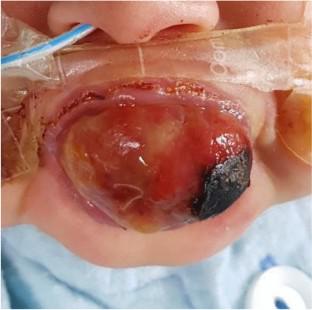SN Comprehensive Clinical Medicine Pub Date : 2024-01-18 , DOI: 10.1007/s42399-024-01640-2 M.C. Navas-Aparicio , A. Acuña-Navas , M. Núñez-Delgado

|
Abstract
The congenital granular cell tumor is a benign soft tissue lesion, unique to the newborn, which originates from the mucosa of the alveolar ridge of the maxillary and mandibular bone in the anterior region. Its diagnosis is made clinically, generally from birth. It is important to learn about this pathology because depending on the size, the tumor can be threatening to the life of the newborn due to mechanical obstruction of the oral cavity, interfering with functions such as swallowing, feeding, proper closure of the oral cavity, and breathing, leading to cyanosis and dyspnea, and being a potential cause of death by asphyxia.
Case Presentation
A 2-day-old girl was in the Neonatology Service, Hospital Nacional de Niños, Caja Costarricense de Seguro Social, for presenting a tumor in the mouth, which was diagnosed by ultrasound in the prenatal period, and for which she was admitted due to possible respiratory distress and clinical deterioration. In her evaluation, a rounded, mobile, fibrous, vascularized lesion of approximately 40 mm × 40 mm was observed, with a wide base adhered to the maxillary alveolar ridge vestibular mucosa. Therefore, it was decided to schedule surgery for excision and biopsy of the tumor. The histopathological study indicated a diagnosis of congenital ulcerated epulis.
Conclusion
The clinical presentation of congenital granular cell tumor, in these case, is impressive due to its size and aggressive appearance, which is important for health professionals to know the characteristics of this benign, rare, and congenital tumor to avoid complications and decide on the procedure to follow.
中文翻译:

新生儿先天性大颗粒细胞瘤的诊断与治疗:病例报告与文献复习
摘要
先天性颗粒细胞瘤是一种新生儿特有的良性软组织病变,起源于上颌骨和下颌骨前牙区牙槽嵴的粘膜。其诊断是通过临床进行的,通常是从出生开始。了解这种病理学非常重要,因为根据大小,肿瘤可能会由于口腔机械性阻塞、干扰吞咽、进食、口腔正常闭合等功能而威胁新生儿的生命。和呼吸,导致发绀和呼吸困难,是窒息死亡的潜在原因。
案例展示
一名出生仅 2 天的女孩因口腔内出现肿瘤而在 Caja Costarricense de Seguro Social 国家医院新生儿科就诊,该肿瘤在产前通过超声波诊断出来,并因以下原因入院治疗:可能出现呼吸窘迫和临床恶化。在她的评估中,观察到约 40 mm × 40 mm 的圆形、可移动、纤维性、血管化病变,其宽基底粘附于上颌牙槽嵴前庭粘膜。因此,决定安排手术切除肿瘤并进行活检。组织病理学研究表明诊断为先天性溃疡性牙龈瘤。
结论
在这些病例中,先天性颗粒细胞肿瘤的临床表现因其大小和侵袭性外观而令人印象深刻,这对于卫生专业人员了解这种良性、罕见和先天性肿瘤的特征以避免并发症并决定手术非常重要跟随。



























 京公网安备 11010802027423号
京公网安备 11010802027423号